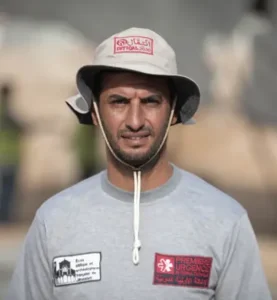‘We can’t take any of this for granted’: Gaza’s fight to keep its treasures safe at home

Palestinian farmer Salman al-Nabahin and his son clean the Byzantine mosaic floor he discovered at his farm in Gaza.
Bethan McKernan and Hazem Balousha write in The Observer:
There is considerable debate over the origin of the name Gaza. Some etymologists trace it back to azaz, which means “strong” in Semitic languages; other accounts believe it derives from the Persian word ganj, which means “treasure”.
It’s true that you almost can’t move for ancient treasures in the tiny blockaded strip. Fishers, farmers and construction workers regularly uncover elements of Gaza’s 5,000-year-old past in the course of a day’s work.
In 2013, a priceless life-size bronze statue of Apollo was supposedly found in the Mediterranean by a fisher, who said he was afraid at first he had stumbled across a body in the shallows; last year, a farmer planting trees unearthed an exceptionally beautiful Byzantine mosaic floor of birds and animals, its colours still bright.

Fadel al-Atul, of the Palestinian excavation team working in a Roman-era cemetery in the north of Gaza
Gaza’s image today is that of a place of war and suffering. The forces that make life a misery for the 25.5 mile by 7.5 mile enclave’s population of 2.3 million people also threaten its rich history: valuable items can be seized by Hamas, the militant group that controls the strip, or sold by smugglers to collectors abroad. There is little funding and equipment to adequately excavate or maintain historical sites. Sometimes they are damaged in Israeli offensives.
A clutch of dedicated archaeologists and activists in the strip, however, is determined not to let Gaza’s contributions to civilisation be forgotten, working hard to preserve the area’s ancient past despite the many challenges they face.
“No one here has formal training. I’m basically the best we’ve got. There’s a small department attached to the architecture school at the Islamic University, but that’s it,” said Fadel al-Atul, Gaza’s foremost archaeologist.
